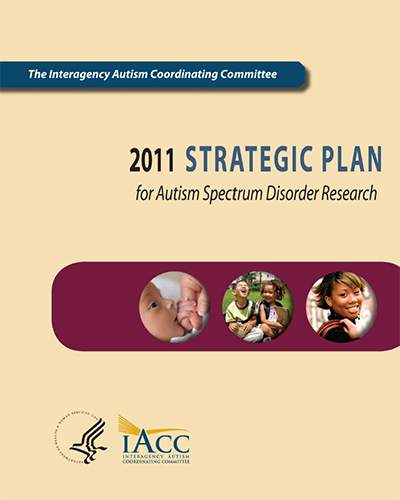IACC Strategic Plan
For Autism Spectrum Disorder Research
2011
Question 1: When Should I Be Concerned?
A child's caregivers are often first to identify the signs of ASD. In the classic case, there may be delays or plateaus in a child's attainment of developmental milestones, such as the use of gestures, responding to name, or the onset of speech and pretend play. In other cases, the first signs of ASD occur in young children who appear to regress after they seem to have been developing normally. Current diagnostic criteria and classifications of ASD represent progress in identifying a core set of developmental symptoms that, in the past, might have been attributed to other disorders because of more narrowly defined ASD evaluation criteria. Read more.
Question 2: How Can I Understand What Is Happening?
Researchers, clinicians, and families have long posed questions about the possible biological bases of ASD. Clinicians classify ASD as a developmental brain disorder based on the behavioral features required for diagnosis. Little evidence exists, however, for a specific neurological abnormality beyond reports of an exuberant and transient pattern of brain or head growth (Akshoomoff, Pierce & Courchesne, 2002; Dawson et al., 2007; Hazlett et al., 2005). Read more.
Question 3: What Caused This to Happen and Can It Be Prevented?
As with many complex disorders, causation is generally thought to involve some forms of genetic risk interacting with some forms of non-genetic environmental exposure. The balance of genetic risk and environmental exposure likely varies across the spectrum of ASD. The greatly increased concordance of strictly defined autism in monozygotic (identical) twins (70 - 90%) compared to dizygotic (fraternal) twins (0 - 10%) argues for the importance of genetic factors (Bailey et al., 1995; Steffenburg et al., 1989). Read more.
Question 4: Which Treatments and Interventions Will Help?
Although autism is defined and diagnosed by deficits in core behaviors, accumulating evidence suggests that the breadth of this disorder extends well beyond the behavioral diagnosis. There is increasing recognition that the multiple systemic issues in children with ASD may influence vulnerability, onset, and severity of symptoms and behaviors. The systemic component of autism supports the possibility that both the core behaviors and medical issues have a convergent mechanistic basis that, if identified, could provide new insights into treatment targets, candidate genes, and strategies for prevention. Read more.
Question 5: Where Can I Turn for Services?
To fulfill the mission to "profoundly improve the health and well-being of every person on the autism spectrum across the lifespan," scientific discoveries must be implemented in communities and supported by public policy. The gap between knowledge and action can only be overcome by an aggressive focus on engaging families, people with ASD, and the services community in the research process, disseminating research findings into the community, eliminating barriers to services, and helping people with ASD and their families identify which services are needed. Read more.
Question 6: What Does the Future Hold, Particularly for Adults?
An overarching goal of ASD research is to enable people with ASD to lead fulfilling and productive lives in the community. We are in critical need of information about the current landscape of long-term outcomes for all people with ASD across the spectrum. The lack of knowledge about adults with ASD and their lifetime support needs has repeatedly arisen as a critical issue when stakeholders are queried about their most fundamental concerns. Longitudinal studies designed to capture the range of possible outcomes for people with ASD are best suited to inform public policy decision-making, service and support delivery, and funding strategies. Read more.
Question 7: What Other Infrastructure and Surveillance Needs Must Be Met?
Current infrastructure may be insufficient to adequately support the research programs outlined in this plan. Additional investment in infrastructure is necessary to collect and share data among researchers, to encourage and enable individuals with ASD and their families to participate in research, and to improve the speed with which findings are disseminated and the extent to which findings are translated into practice and policy. Read more.




